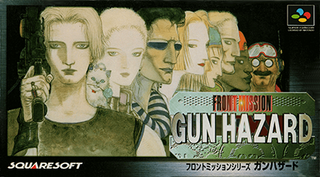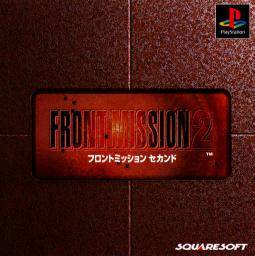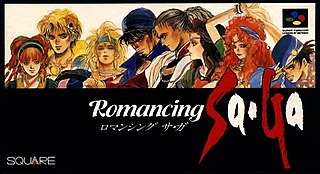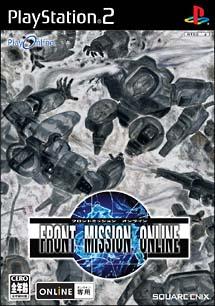Square Co., Ltd. was a Japanese video game development studio and publisher. It was founded in 1986 by Masafumi Miyamoto, who spun off part of his father's electronics company Den-Yu-Sha. Among its early employees were designers Hironobu Sakaguchi, Hiromichi Tanaka, Akitoshi Kawazu and Koichi Ishii, artist Kazuko Shibuya, programmer Nasir Gebelli, and composer Nobuo Uematsu. Initially focusing on action games, the team saw popular success with Final Fantasy in 1987. A role-playing video game, it became the first in a franchise of the same name. Later notable staff included directors Yoshinori Kitase and Takashi Tokita, designer and writer Yasumi Matsuno, artists Tetsuya Nomura and Yusuke Naora, and composers Yoko Shimomura and Masashi Hamauzu.

Final Fantasy Tactics is a tactical role-playing game developed and published by Square for the PlayStation video game console. Released in Japan in June 1997 and in the United States in January 1998 by Sony Computer Entertainment, it is the first game of the Tactics series within the Final Fantasy franchise, and the first entry set in the fictional world later known as Ivalice. The story follows Ramza Beoulve, a highborn cadet placed in the middle of a military conflict known as The Lion War, where two opposing noble factions are coveting the throne of the kingdom.

Final Fantasy III is a role-playing video game developed and published by Square for the Family Computer. The third installment in the Final Fantasy series, it is the first numbered Final Fantasy game to feature the job-change system. The story revolves around four orphaned youths drawn to a crystal of light. The crystal grants them some of its power, and instructs them to go forth and restore balance to the world. Not knowing what to make of the crystal's pronouncements, but nonetheless recognizing the importance of its words, the four inform their adoptive families of their mission and set out to explore and bring back balance to the world.
Front Mission is a collection of video games and related media produced by Square, now Square Enix. The series was created by Toshiro Tsuchida and developed by G-Craft, a studio that was later absorbed by Square and existed within Square Enix as Product Development Division-6. Since the release of the original Front Mission in 1995, the series has gone on to encompass several media, including film, manga, novels, radio dramas, mobile phone applications, and toys. While the series is primarily rooted in the turn-based tactical role-playing genre, it has also ventured into other genres such as side-scrolling shooter, real-time strategy (RTS), massive multiplayer online (MMO), and third-person shooter through its spin-offs. The Front Mission video games achieved moderate success, selling over 3 million units worldwide up until January 2006.
PlayOnline is an online gaming service owned by Square Enix as the launcher application and Internet service for many of the online PC, PlayStation 2 and Xbox 360 games the company publishes. Launched on June 6, 2000, the service hosted games including Front Mission Online, Fantasy Earth: The Ring of Dominion, Tetra Master, and the Japanese releases of EverQuest II, Dirge of Cerberus: Final Fantasy VII and JongHoLo. As of 2022, however, the PC version of Final Fantasy XI is the only remaining game supported by the service.

Star Ocean: The Second Story, known in Japan as Star Ocean: Second Story, is an action role-playing video game developed by tri-Ace and published by Enix for the PlayStation. It is the second game in the Star Ocean series and the first game in the series to be released outside Japan, arriving in North America in June 1999 and Europe in April 2000, by Sony Computer Entertainment. Taking place in a science fantasy universe, the story centers around a young man named Claude C. Kenny, a cadet from a space-faring Earth organization who is stranded on an undeveloped, medieval-level planet. There, he meets several companions and must stop a plot from an evil organization that spans multiple worlds before finding his way home. The game was the basis of manga and anime adaptations.

Legend of Mana is a 1999 action role-playing game developed and published by Square for the PlayStation. It was the fourth game released in the Mana series, following 1995's Trials of Mana. Set in a high fantasy universe, the game follows an unnamed hero as they restore the land of Fa'Diel by creating the world around them and completing a number of interrelated quests in order to restore the Tree of Mana.

Front Mission Series: Gun Hazard is a 1996 side-scrolling shooter game developed by Omiya Soft and published by Squaresoft for the Super Famicom. It was released only in Japan on February 23. Gun Hazard is the second entry in the Front Mission series and is a side-scrolling shooter with role-playing game elements. The game received an English language fan translation in 2004.

Front Mission 2, also known in Japan as Front Mission Second, is a tactical role-playing game for the Sony PlayStation developed by G-Craft and published by Square, and was released in Japan on September 25, 1997. Front Mission 2 is the second main entry and the third entry overall in the Front Mission series. Like other Front Mission titles, Front Mission 2 is part of a serialized storyline that follows the stories of various characters and their struggles involving mecha known as wanzers. The game was well received by critics and fans, and was part of Square Enix's "Ultimate Hits" collection in 2005.

Romancing SaGa is a 1992 role-playing video game developed and published by Square for the Super Famicom. It is the fourth entry in the SaGa series. It was subsequently released for the WonderSwan Color in 2001 and mobile phones in 2009. A remake for the PlayStation 2, subtitled Minstrel Song in Japan, was released in both Japan and North America in 2005 by Square Enix. A remaster of Minstrel Song was released worldwide in 2022 for Android, iOS, Nintendo Switch, PlayStation 4, PlayStation 5 and Windows.

Front Mission 4, also known in Japan as Front Mission Fourth, is a tactical role-playing game developed and published by Square Enix Co., Ltd. as the fourth main entry and sixth entry overall in the Front Mission series. Like other Front Mission titles, Front Mission 4 is part of a serialized storyline that follows the stories of various characters and their struggles involving mecha known as wanzers.

Front Mission Alternative is a real-time tactics video game developed and published by Square, and was released in Japan on December 18, 1997. Front Mission Alternative is the second spin-off entry and the fourth entry overall in the Front Mission series. Unlike other Front Mission titles, Front Mission Alternative is the precursor to the serialized storyline and features a completely standalone story and cast of characters.

Front Mission 5: Scars of the War, also known in Japan as Front Mission Fifth: Scars of the War, is a tactical role-playing game developed and published by Square Enix, released in Japan on December 29, 2005. Front Mission 5: Scars of the War is the fifth main entry and ninth entry overall in the Front Mission series. Like other Front Mission titles, Front Mission 5: Scars of the War is part of a serialized storyline that follows the stories of various characters and their struggles involving mecha known as wanzers.

Front Mission is a tactical role-playing game developed by G-Craft and published by Square, and was released in Japan on February 24, 1995 for the Super Famicom. Front Mission is the first main entry and the first entry overall in the Front Mission series. Front Mission is part of a serialized storyline that follows the stories of various characters and their struggles involving mecha known as wanzers. A direct port of the game was released for the WonderSwan Color in Japan on July 12, 2002.

Shinji Hashimoto is a Japanese former game producer at Square Enix and currently senior advisor at Sony Music Entertainment Japan and a board member at Forwardworks. He served as the Final Fantasy series brand manager for over a decade, was an executive officer at Square Enix board of directors and he was the Head of Square Enix's Business Division 3 for 6 years. He is also the co-creator of the Kingdom Hearts series. He served as corporate executive of the company's 1st Production Department during its entire existence.

Front Mission Evolved is a third-person shooter video game developed by Double Helix Games and published by Square Enix. Unlike previous Front Mission titles which have a tactical role-playing game structure, players engage in combat in real time on 3D maps using giant robotic weapons of war known as "Wanzers." The game also features a single player story mode and several multiplayer combat modes with up to eight players.

Front Mission 2089 is a tactical role-playing game developed by Square Enix Co., Ltd., MSF, and Winds, and was published and released in Japan by Square Enix Co., Ltd. in 2005 and 2008 for mobile phones. The game was released on March 7, 2005, October 27, 2005, and June 18, 2008. Front Mission 2089 is part of Front Mission Mobile, a project dedicated to Front Mission video games for the mobile phones. Front Mission 2089 is the fifth main entry and the seventh entry overall in the Front Mission series. Like other Front Mission titles, Front Mission 2089 is part of a serialized storyline that follows the stories of various characters and their struggles involving mecha known as wanzers. An enhanced remake of the game developed by h.a.n.d. was released for the Nintendo DS on May 29, 2008, titled Front Mission 2089: Border of Madness. A sequel, Front Mission 2089-II, was released for mobile phones in Japan in 2006 and 2008 for i-mode and EZweb services, respectively, continuing the story following a new main character.

Front Mission: Online was a massively multiplayer online (MMO), third-person shooter video game developed by and published by Square Enix, and was released in Japan on May 12, 2005 for the PlayStation 2, and on December 8, 2005 for Windows. Like other Front Mission titles, Front Mission: Online is part of a serialized storyline that follows the stories of various characters and their struggles involving mecha known as wanzers. The game's servers were closed on May 31, 2008.

Left Alive is a 2019 action-adventure stealth game developed by Ilinx and published by Square Enix. It was released in February and March 2019 for the PlayStation 4 and Windows platforms. It was announced at a press conference by Sony Interactive Entertainment before the 2017 Tokyo Game Show. Set in the universe of the Front Mission series of videogames, the story follows several individuals trying to survive amidst a surprise invasion of their country, while both helping civilians to safety and attempting to stop destruction and damage wrought by Wanzers, a form of combat mecha.

















